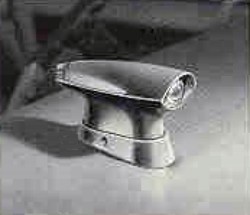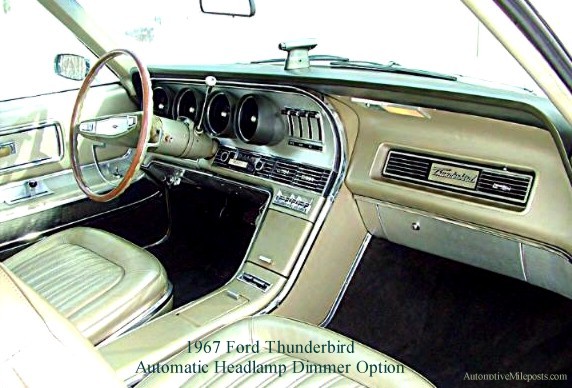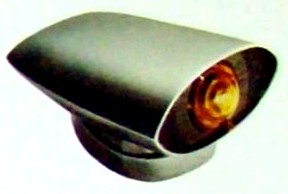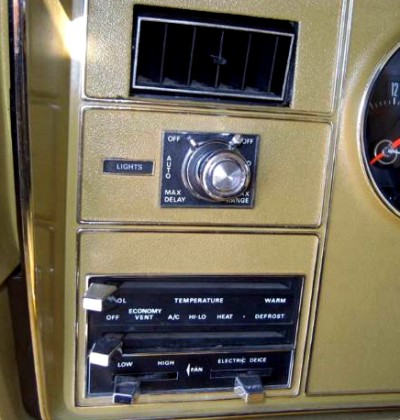Rare Option: Ford Thunderbird Autolamp
and Automatic Headlamp Dimmer
Available 1964-1969, and 1974-1976
 This article deals specifically with automatic headlamp dimmer installations
in the Ford Thunderbird, but we'd like to provide you with a little bit
of background information as well. First introduced by General Motors Corporation
in 1952, the Autronic Eye was an accessory on Cadillac and Oldsmobile automobiles
that year. The option was expanded to other GM divisions over the next
few years, and was heavily promoted by both Chevrolet and Pontiac during
the fifties. The option was revised for 1958, at which point it became
known as Guide-Matic, with the most notable changes being the more compact
housing for the photo eye and an adjustment that allowed the driver to
set the unit to dim when oncoming traffic was near or far. The basic system
components consisted of the photo eye unit which was normally mounted on
the top of the instrument panel, an amplifier, a power relay, a special
foot dimmer switch, and wiring to connect all the components.
This article deals specifically with automatic headlamp dimmer installations
in the Ford Thunderbird, but we'd like to provide you with a little bit
of background information as well. First introduced by General Motors Corporation
in 1952, the Autronic Eye was an accessory on Cadillac and Oldsmobile automobiles
that year. The option was expanded to other GM divisions over the next
few years, and was heavily promoted by both Chevrolet and Pontiac during
the fifties. The option was revised for 1958, at which point it became
known as Guide-Matic, with the most notable changes being the more compact
housing for the photo eye and an adjustment that allowed the driver to
set the unit to dim when oncoming traffic was near or far. The basic system
components consisted of the photo eye unit which was normally mounted on
the top of the instrument panel, an amplifier, a power relay, a special
foot dimmer switch, and wiring to connect all the components.
A sticker mounted on the amplifier identified the particular make and model
for which each unit was built. There is a nine digit serial number on the
sticker, which breaks down as follows:
Example serial number: 864 00001-C
The first digit indicates the division the unit was manufactured for (8=Ford/Mercury/Lincoln)
The second and third digits identify the model year the unit was manufactured
for (64=1964)
The next six digits are the serial number sequence, which begins with 00001
Beginning in 1964, a letter was added to the end of the serial number which
further identified the division the unit was manufactured for (A=Lincoln;
B=Mercury; C=Ford)
So, the example serial number above indicates the unit was the first one
built for a 1964 Ford automobile in the Ford Division, which would include
the Thunderbird.
The first instance of an automatic headlamp dimmer on a Ford Motor Company vehicle was the 1956 Lincoln. However, these units had a high failure rate, so for 1957 Ford sourced Autronic Eye units from General Motors. Over the years, automatic headlamp dimmers have turned up on Thunderbirds as early as 1958, but they were all dealer installations installed at the specific request of a customer. This is a very rare option on any Thunderbird before 1974, at which point the automatic dimmer was paired with an on/off delay system and marketed as Autolamp, which was included with the $160 Light Group, or could be ordered separately for $34. No provision was made for an automatic headlamp dimmer from 1970-1973, although its certainly possible Continental Mark III components could have been added to these cars, likely by the dealer due to a specific customer request.
For the 1964-1966 model years, the Guide-Matic components were located
as follows:
Amplifier unit - mounted in recess behind kick panel on driver's side of car
Foot dimmer switch - replaced factory switch on toeboard
Wiring harness from amplifier/dimmer switch to power relay - harness taped with electrical
tape to instrument panel wiring
Power relay - mounted on left rear radio support bracket, using two hex head screws
Photo eye unit - mounted on top of instrument panel, centered above clock housing assembly
from left to right, and centered between defroster grille and raised padded
ridge on edge of instrument panel from front to rear.
The Guide-Matic photo eye unit was color-keyed to match the top of the
instrument panel, and featured a textured finish. A black plastic knob
on the end facing into the car allowed the driver to set the sensitivity,
and an amber-colored eye faced forward through the windshield. On Thunderbirds
with two tone interiors, such as Parchment with Burgundy appointments,
the photo eye unit would be black, to match the top of the instrument panel,
despite the interior being mostly Parchment in color.
OPERATION OF 1964-1967 UNITS:
The early units (prior to 1968) used tubes in the amplifier, which needed
to warm up before the unit would operate. The warm up time depended to
some degree on the ambient temperature, but was normally less than 30 seconds,
even in very cold weather.
To activate the automatic feature:
1. Turn on headlights.
2. Press the foot dimmer switch down part way to see if high beams come
on. If not, press foot switch down all the way to activate automatic dimming.
When the unit is activated, pressing the foot switch partially turns on
high beams as long as pressure is applied.
3. Adjust control knob on automatic eye to dim lights at desired distance
from oncoming traffic.
4. To turn off automatic dimming, depress foot switch until it clicks.
This allows only low beam headlamps.
5. Control knob on some units could be turned all the way counterclockwise
to turn off automatic dimming and allow manual operation of headlamps.

Above: 1964-1967-style Ford Thunderbird Automatic Headlamp Dimmer shown installed in a 1967 Thunderbird. This unit had a separate tube-type amplifier unit. New model would be introduced for 1968, which was much improved and no longer used tubes or required a warm up period.

Above: 1968-1969 Ford Thunderbird Automatic Headlamp Dimmer unit was solid state, and the sensor mounted outside on the cowl panel.
A new, simpler Automatic Headlamp Dimmer was introduced for 1968, and would
be used through 1969 on the Ford Thunderbird, as well as on the 1968-1969
Lincoln Continentals and 1968-1971 Continental Mark III. The photo eye
component was mounted outside on the cowl panel on the driver's side of
the car. In this location, the photo eye had an unobstructed view of the
road ahead, which eliminated reflections on the windshield glass which
sometimes caused issues on the older units.
On the Lincoln vehicles, this unit was painted to match the exterior color. On the Thunderbirds, this unit featured a polished chrome base and underside of the photo cell unit. The top of the photo cell unit was brushed chrome to reduce glare, which Ford called a "satylite finish."
This unit featured a solid state sensor and amplifier, so no warm up was required. (Ford kit part number C8AZ-13A016-A) The 1969 Ford Accessories brochure listed this as available only for the Fairlane and Falcon, but installation instructions provided in the kit included Thunderbird as well as other makes and models. For some strange reason, the instructions called for the on/off/sensitivity control, which was a separate component on this particular model, to be mounted inside the console glove compartment on Thunderbirds. No mention was made for Thunderbirds with front bench seats and no console! Units with bench seats normally have this control mounted on the underside of the instrument panel, below the headlight switch, in the area near the speed control on/off switch and left and right floor vents, depending on installation of those items.
There was no automatic headlamp dimmer available for the 1970-1973 Thunderbirds,
due to the fact that there was no place to mount the external photo eye.
The 1970-71 Thunderbirds no longer had a cowl panel, as the hood was extended
to conceal the windshield wipers. The front fenders had a ridge line that
further made mounting a difficult proposition on these cars. The 1972-73
Thunderbirds had similar difficulties. Lincoln offered a concealed photo
eye during this period, but there's no information to date to indicate
that any Lincoln units were ever installed on 1970-1973 Thunderbirds, although
its certainly possible that they were.
 For 1974, a new Autolamp option (controls shown at left) was offered that not only provided automatic dimming, but also included
a delay system that would shut off the headlamps automatically after the
driver exited the car and was safely inside. The delay could be set for
30, 60, or 90 seconds on the 1974 models, 1975-1976 cars used a variable
rheostat that allowed for any length of time between 30 and 90 seconds.
Additionally, either front cornering lamp could be lit to provide additional
light to the side of the car by moving the turn signal lever up or down
to light the desired cornering lamp.
For 1974, a new Autolamp option (controls shown at left) was offered that not only provided automatic dimming, but also included
a delay system that would shut off the headlamps automatically after the
driver exited the car and was safely inside. The delay could be set for
30, 60, or 90 seconds on the 1974 models, 1975-1976 cars used a variable
rheostat that allowed for any length of time between 30 and 90 seconds.
Additionally, either front cornering lamp could be lit to provide additional
light to the side of the car by moving the turn signal lever up or down
to light the desired cornering lamp.
For 1974, the automatic dimmer was available separately as well as being included in the Light Group option. For 1975 and 1976, the Light Group had to be ordered as no separate automatic dimmer was offered. Most people ordered the Light Group anyway, as it included Dual Overhead Map Lights, Illuminated Visor Vanity Mirror, Warning Lights for "Low Fuel", "Door Ajar", "Lights On" (with Buzzer), Engine Compartment Light, and the Autolamp system.
On the Autolamp systems, the sensor was mounted behind the grille and the controls were incorporated with the headlamp switch. While this was nice since it concealed most of the components, it did expose the sensor to road grime, which would eventually cause it to not work properly since it was protected when the car was washed. Unlike earlier models with this sensor mounted externally where it would be kept clean when the car was washed, owners of cars with Autolamp were required to periodically wipe off the sensor lens with a soft cloth, but many failed to do so and just shut the system off when it quit working properly. (Because the dirty lens didn't allow light through, the symptom was headlamps that failed to dim when oncoming traffic required low beam headlights.)
A buzzer sounded upon exiting to remind the driver that the headlamps were on if the headlamp switch was pulled out to turn the lights on, even if the Autolamp system was on, as the headlamp switch always overrode the Autolamp system when turning the lights on. With the Light Group option, a light on the instrument panel also warned that the lights were on.
AUTOMATIC HEADLAMP DIMMER PRICING:
1964-1967 Thunderbird: $45.60
1968-1969 Thunderbird: $51.20
1974 Thunderbird: $34 (Automatic dimmer as a separate option) or
$160 (Included with optional Light Group)
1975-1976 Thunderbird: $164 (Included with optional Light Group; not available
separately)
When Ford down sized the Thunderbird in 1977, a few of the premium luxury features that had been available in 1976 were no longer offered. Included was the Autolamp system, along with the power antenna (made available again for 1978), and the Driver's Side Power Lumbar Seat. A Headlamp Convenience Group continued to be offered on the 1977 Continental Mark V, which included what was the Autolamp system, but no corresponding option was offered on the T-bird during this period.
Automotive Mileposts has had inquiries in the past from visitors requesting more information on the automatic headlight dimmer option. They were concerned about its authenticity since it wasn't mentioned in owner's manuals, sales literature, or shop manuals at the time. This really isn't unusual, as other items have been omitted from printed material over the years, for instance no mention is made of the vacuum door lock option in the 1963 Thunderbird owner's manual; operation of the standard map light switch isn't included in the 1964 Thunderbird owner's manual; and there are numerous instances of information not included in shop manuals over the years.
Ford made quite a bit of profit on optional equipment at this time, and since the Thunderbird's competition was offering the automatic headlight dimmer as an option, it is unlikely that Ford would chance missing a sale by refusing to offer it as well, especially since the components to install it were available at the Wixom Assembly Plant for use on the Lincoln Continental. Automotive Mileposts has verified two mid-sixties Thunderbirds with factory-installed automatic headlight dimmers. The first was a 1965 Thunderbird Landau, which had every option offered in 1965 except for leather upholstery and a deck lid luggage rack. The Caspian Blue car still had the original window sticker in the glove box, and it listed the headlight dimmer as an option. This car was located in a salvage yard in Tulsa, Oklahoma in 1975, which closed years ago and today there's little left to identify what was once in that location. The rare fuel filler door edge guard was removed from the car at the time, as was the StudioSonic Sound System, but many other rare options, including the automatic dimmer, weren't.
The second car was a 1966 Thunderbird Town Landau, and an eyewitness clearly remembers the photo eye mounted on the instrument panel as the car was backed off the delivery truck at the dealership. This car also included the automatic dimmer as an option listed on the window sticker. It's foolish to think that just because someone hasn't ever seen a car with a particular option over the years, that none ever existed. This is a very rare option that was likely included only by special order. It's important to remember that during the sixties roadways were much darker than they are today. More people lived in rural areas and drove on two lane country roads to get to and from town. For luxury car buyers, the automatic headlamp dimmer was a welcome feature that was used regularly.
There's little doubt that at a minimum, the automatic dimmer was offered as a factory authorized dealer-installed accessory, which makes it correct for Thunderbirds of this era. As far as we know, most clubs allow for factory authorized accessories installed by dealers when judging cars at shows. As long as the part is authorized by Ford and installed per the guidelines provided by Ford, no points are deducted for the accessory. In some instances, specific instructions weren't provided, and installation was left to the dealer's discretion. And in that case, as long as it was installed appropriately, it is accepted as correct for the car.
As noted above, the 1965 Landau is long gone now, and the window sticker wasn't retained, nor were photographs taken of the car. Photos do exist of the 1966 Town Landau, but the photo eye is difficult to see in the photos. Nevertheless, a search is underway to locate additional photos of the '66, and those images will be published on this page if and when the photos are found. The automatic headlamp dimmer is a convenient option to have if you drive your Thunderbird at night, and attract a lot of attention on cars with the photo eye exposed.